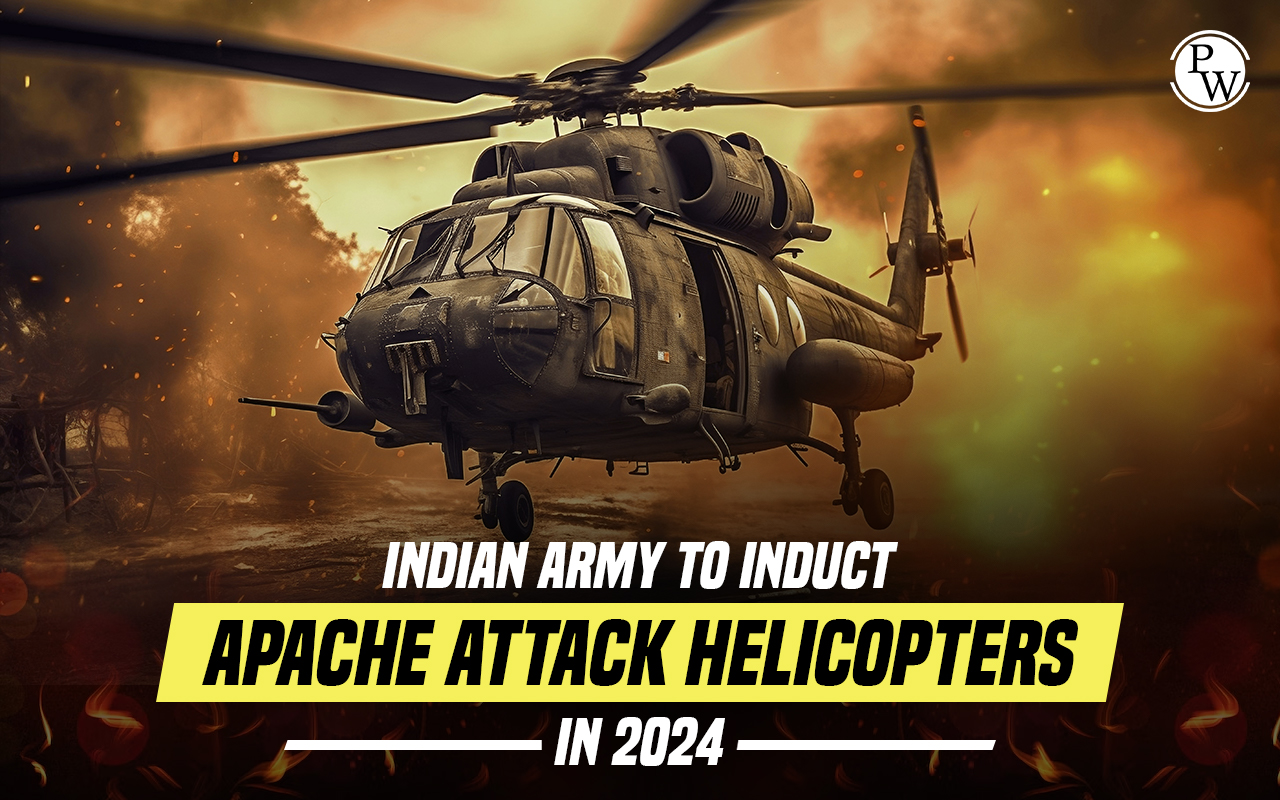

Indian Army to induct Apache Attack Helicopters: In 2020, the Indian Army made an agreement with the American aviation company Boeing to buy six AH-64E Apache attack helicopters for $930 million. The Indian Air Force (IAF) already has 22 AH-64E Apaches, which they got in 2015 for about $1.4 billion. The first of the new helicopters will arrive in February 2024, and the other five will come by April 2024.
The new Apache attack helicopters, often referred to as "tank-killers," will significantly boost the army's ability to conduct air attacks. These helicopters will be positioned in the desert region, across from Pakistan.
Apache Attack Helicopters in India
The induction of Apache Attack helicopters will provide strength to Army's readiness and firepower. Renowned for their advanced technology and versatility, these helicopters are one of the strongest and most efficient aerial assets, adept at executing a diverse range of missions, from close air support to anti-tank warfare and reconnaissance.
- Apache helicopters come with Hellfire precision-strike missiles and air-to-air Stinger missiles.
- Out of the IAF's 22 Apaches, 11 are outfitted with the Longbow fire control radar system, enhancing their ability to engage armored units.
- The Apache's chin-mounted gun can discharge 625 armor-penetrating rounds every minute, providing high effectiveness against a range of targets.
The first Apache is expected to reach India in February 2024, with all six helicopters expected to be fully operational by April 2024. However, the Apache isn't the sole contributor to India's enhanced aerial prowess. The Defense Acquisition Council (DAC) is set to evaluate a larger contract for 156 indigenous Light Combat Helicopters (LCH) in the coming week.
Indigenous Light Combat Helicopters (LCH) Prachand
The Defense Acquisition Council (DAC) is all set to approve a contract for the production of 156 indigenous Light Combat Helicopters (LCH) named 'Prachand', with a total value of ₹45,000 crore. This impressive fleet is divided into 90 helicopters for the Army and 66 for the Indian Air Force. The LCH holds the distinction of being the Army's very first dedicated attack helicopter, marking a significant advancement in their aviation capabilities. The army has already introduced a squadron of LCH Prachand helicopters in the eastern sector.
- LCH Prachand is a twin-engine attack helicopter designed for high-altitude Ladakh regions, with the ability to operate from 16,000-foot-high helipads and carry a substantial combat load.
- It features a nose-mounted cannon firing a thousand 20-millimeter bullets per minute, along with 70-millimeter rockets on pods and air-to-air and anti-armor missile capabilities.
- The LCH has successfully test-fired European firm MBDA's Mistral air-to-air missile and HAL has integrated Mistral-specific launchers on the platform.
Manufactured by Hindustan Aeronautics Limited (HAL), the LCH signifies India's top-tier self-reliant manufacturing. Procuring these helicopters not only makes India's indigenous defense industry strong but also reduces its dependence on foreign suppliers. This reflects the Indian Army's dedication to harnessing its own innovations and strengthening the nation's defense sector.
Also Check, Indian Army History, Roles, and FunctionsBenefits of Apache Helicopters in India
The Apache helicopters are equipped with advanced technology, night vision, and precise weapons, providing a significant advantage in the desert. They can handle tough terrain and extreme heat which makes them perfect for the Indian Army because they can keep the country safe as per the geography and temperature of the country.
Furthermore, the integration of Apaches alongside the indigenous Light Combat Helicopters (LCH) will not only enhance the Army's operational efficiency but also promote synergy with the Indian Air Force. These helicopters' seamless coordination with other aerial assets, including fighter jets and transport helicopters, will facilitate joint military operations, substantially improving overall combat effectiveness.
As the Indian Army prepares to introduce these aerial assets, it is also planning for the procurement of an additional 11 Apaches. The decision is contingent upon a thorough assessment of the necessity for armored helicopters, underscoring the Army's commitment to continuously evaluate and enhance its operational capabilities to address evolving security challenges. This proactive approach ensures that the Indian Army remains prepared and adaptive in safeguarding the nation's security interests.
Indian Army to induct Apache Attack Helicopters in 2024 FAQs
Q: What helicopters is the Indian Army set to induct in 2024?
Q2. What was the deal of Indian Army Apache attack helicopters?
Q3. What advantages do the Apache helicopters bring to the Indian Army?
Q4. Where are these Apache helicopters going to be deployed?
Q5. What is the significance of the indigenous Light Combat Helicopters (LCH) Prachand?











